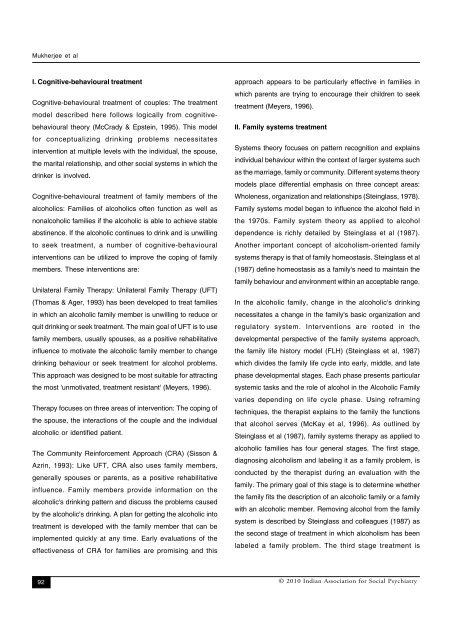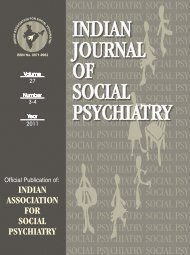IJSP-2010(3-4) - Indian Association For Social Psychiatry
IJSP-2010(3-4) - Indian Association For Social Psychiatry
IJSP-2010(3-4) - Indian Association For Social Psychiatry
Create successful ePaper yourself
Turn your PDF publications into a flip-book with our unique Google optimized e-Paper software.
Mukherjee et al<br />
I. Cognitive-behavioural treatment<br />
Cognitive-behavioural treatment of couples: The treatment<br />
model described here follows logically from cognitivebehavioural<br />
theory (McCrady & Epstein, 1995). This model<br />
for conceptualizing drinking problems necessitates<br />
intervention at multiple levels with the individual, the spouse,<br />
the marital relationship, and other social systems in which the<br />
drinker is involved.<br />
Cognitive-behavioural treatment of family members of the<br />
alcoholics: Families of alcoholics often function as well as<br />
nonalcoholic families if the alcoholic is able to achieve stable<br />
abstinence. If the alcoholic continues to drink and is unwilling<br />
to seek treatment, a number of cognitive-behavioural<br />
interventions can be utilized to improve the coping of family<br />
members. These interventions are:<br />
Unilateral Family Therapy: Unilateral Family Therapy (UFT)<br />
(Thomas & Ager, 1993) has been developed to treat families<br />
in which an alcoholic family member is unwilling to reduce or<br />
quit drinking or seek treatment. The main goal of UFT is to use<br />
family members, usually spouses, as a positive rehabilitative<br />
influence to motivate the alcoholic family member to change<br />
drinking behaviour or seek treatment for alcohol problems.<br />
This approach was designed to be most suitable for attracting<br />
the most 'unmotivated, treatment resistant' (Meyers, 1996).<br />
Therapy focuses on three areas of intervention: The coping of<br />
the spouse, the interactions of the couple and the individual<br />
alcoholic or identified patient.<br />
The Community Reinforcement Approach (CRA) (Sisson &<br />
Azrin, 1993): Like UFT, CRA also uses family members,<br />
generally spouses or parents, as a positive rehabilitative<br />
influence. Family members provide information on the<br />
alcoholic's drinking pattern and discuss the problems caused<br />
by the alcoholic's drinking. A plan for getting the alcoholic into<br />
treatment is developed with the family member that can be<br />
implemented quickly at any time. Early evaluations of the<br />
effectiveness of CRA for families are promising and this<br />
92<br />
approach appears to be particularly effective in families in<br />
which parents are trying to encourage their children to seek<br />
treatment (Meyers, 1996).<br />
II. Family systems treatment<br />
Systems theory focuses on pattern recognition and explains<br />
individual behaviour within the context of larger systems such<br />
as the marriage, family or community. Different systems theory<br />
models place differential emphasis on three concept areas:<br />
Wholeness, organization and relationships (Steinglass, 1978).<br />
Family systems model began to influence the alcohol field in<br />
the 1970s. Family system theory as applied to alcohol<br />
dependence is richly detailed by Steinglass et al (1987).<br />
Another important concept of alcoholism-oriented family<br />
systems therapy is that of family homeostasis. Steinglass et al<br />
(1987) define homeostasis as a family's need to maintain the<br />
family behaviour and environment within an acceptable range.<br />
In the alcoholic family, change in the alcoholic's drinking<br />
necessitates a change in the family's basic organization and<br />
regulatory system. Interventions are rooted in the<br />
developmental perspective of the family systems approach,<br />
the family life history model (FLH) (Steinglass et al, 1987)<br />
which divides the family life cycle into early, middle, and late<br />
phase developmental stages. Each phase presents particular<br />
systemic tasks and the role of alcohol in the Alcoholic Family<br />
varies depending on life cycle phase. Using reframing<br />
techniques, the therapist explains to the family the functions<br />
that alcohol serves (McKay et al, 1996). As outlined by<br />
Steinglass et al (1987), family systems therapy as applied to<br />
alcoholic families has four general stages. The first stage,<br />
diagnosing alcoholism and labeling it as a family problem, is<br />
conducted by the therapist during an evaluation with the<br />
family. The primary goal of this stage is to determine whether<br />
the family fits the description of an alcoholic family or a family<br />
with an alcoholic member. Removing alcohol from the family<br />
system is described by Steinglass and colleagues (1987) as<br />
the second stage of treatment in which alcoholism has been<br />
labeled a family problem. The third stage treatment is<br />
© <strong>2010</strong> <strong>Indian</strong> <strong>Association</strong> for <strong>Social</strong> <strong>Psychiatry</strong>



